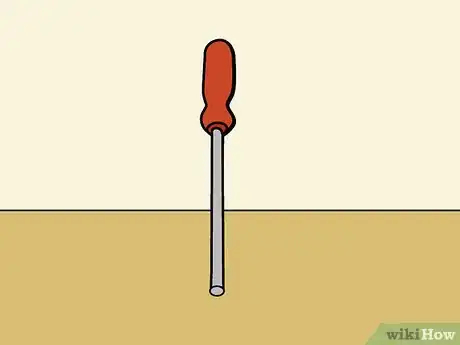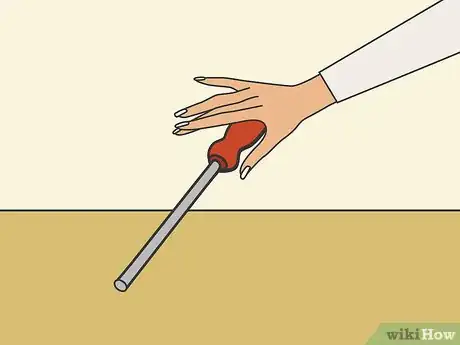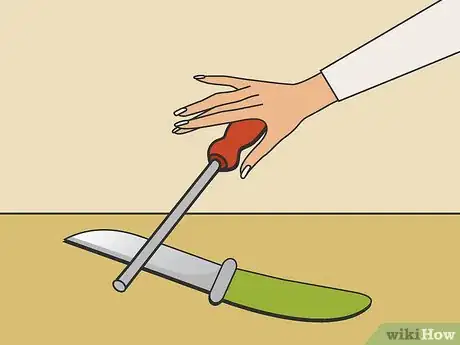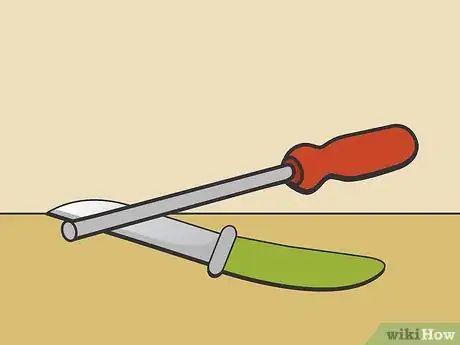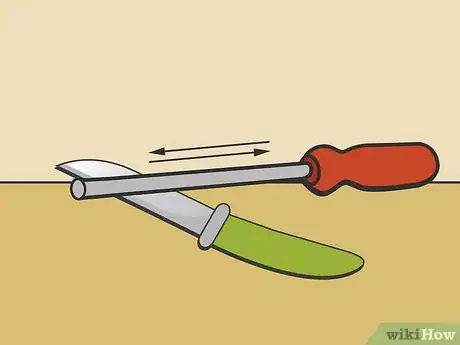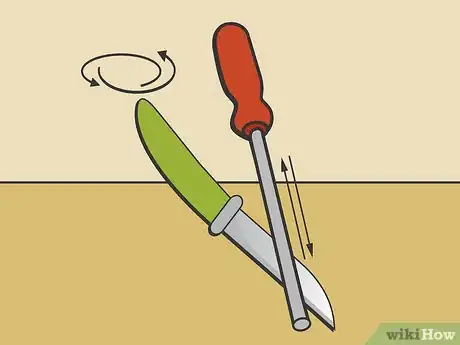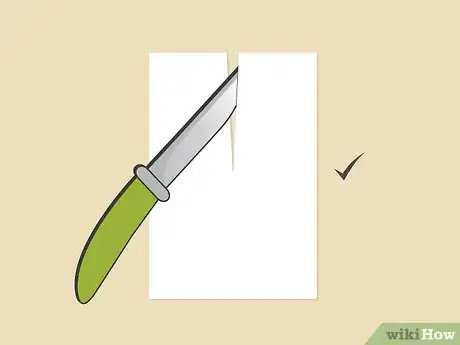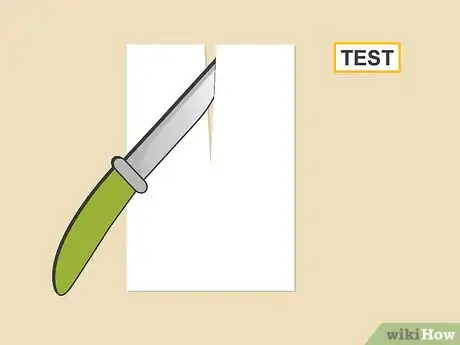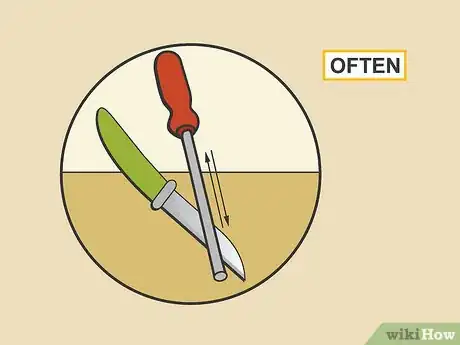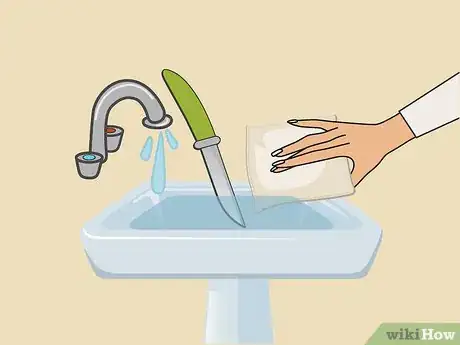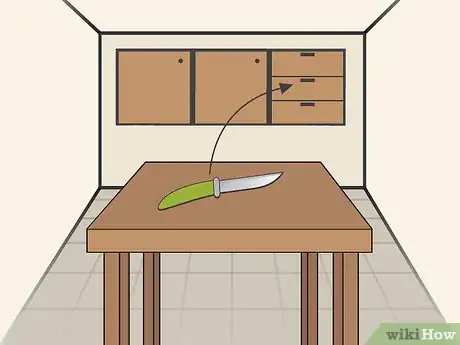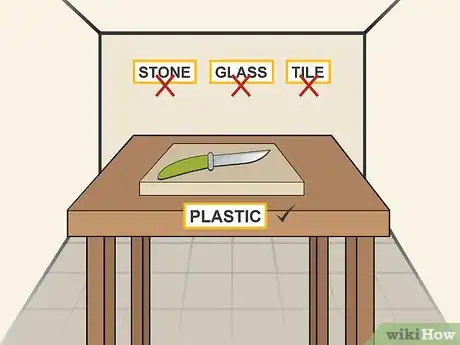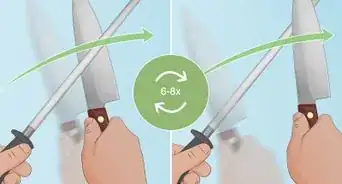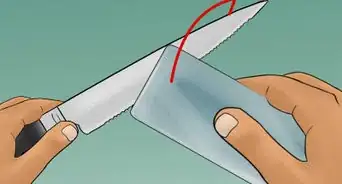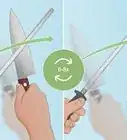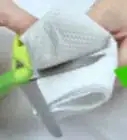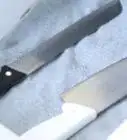This article was co-authored by wikiHow staff writer, Jessica Gibson. Jessica Gibson is a Writer and Editor who's been with wikiHow since 2014. After completing a year of art studies at the Emily Carr University in Vancouver, she graduated from Columbia College with a BA in History. Jessica also completed an MA in History from The University of Oregon in 2013.
wikiHow marks an article as reader-approved once it receives enough positive feedback. In this case, 100% of readers who voted found the article helpful, earning it our reader-approved status.
This article has been viewed 280,178 times.
Learn more...
If you bought a set of knives, it probably came with a sharpening, or honing steel. Honing will keep your blades sharper for longer, especially since honing will not remove part of the metal blade as sharpening does. When you use the honing steel properly, you can actually push the blade of a knife back into the correct position. Hold the honing steel vertically and move the knife blade down at an angle. Maintain your sharp knives to prevent damage to the blades.
Steps
Positioning Your Tools
-
1Hold the sharpening steel point-down on your work surface. Hold the handle of the honing steel in your non-dominant hand, so that it's protected by the guard at the top of the handle. Point the tip of the steel down onto a sturdy work surface. The honing steel should be completely vertical.[1]
- The honing steel should be firmly pressed against the work surface so it won't slide when you begin honing the knife.
-
2Position the steel at arm’s length in front of you. To prevent injury, keep the honing steel arm's length in front of you. Even if the honing steel slips, it will be far enough from you to prevent the knife blade from cutting you.[2]Advertisement
-
3Place the knife blade against the honing steel. Take the knife you want to hone and press the bottom (heel) of it against the top of the steel. The blade should be near the handle and positioned as if you were going to cut into the honing steel.[3]
-
4Angle the knife at 15 to 20 degrees. Tilt the knife so it's at a 15 to 20-degree angle. You can adjust the degree to a lower angle for a sharper edge, or a higher angle for a more durable one.
Honing the Knife
-
1Run the blade down the steel as you pull it toward you. Smoothly bring the knife down and towards yourself on the honing steel. Keep the knife at the same angle as you move the knife. The tip of the knife should be at the base of the steel.[4]
- You only need to apply light pressure as you move the blade. You should also move the blade slowly to reduce the risk of cutting yourself.
-
2Run the other side of the knife down the steel. Keep holding the honing steel vertically. To hone the other side of the knife, place the bottom (heel) of the blade on the other side of the steel near the top. Apply light pressure and bring the blade down the steel.[5]
-
3Hone each side of the knife blade 5 to 10 times. Depending on how hard or dull your knife is, you'll need to run each side of the blade down the honing steel 5 to 10 times. You can either completely hone one side at a time or alternate them so long as you hone them the same number of times.[6]
-
4Wipe the blade clean with a soft cloth. Rinse the blade of the knife under running water and then dry the blade with a soft cloth. While honing shouldn't remove metal from the blade, microscopic metal filings might have come off the blade.
-
5Test the sharpness of the knife. If your knives still won't cut through paper after you've used the honing steel, they may be too dull, pitted, or nicked. You can either use a sharpening stone, electric knife sharpener, or have the knives professionally sharpened.[7]
Maintaining Your Knives
-
1Check the sharpness of your knives frequently. Determine which of your knives needs honing by holding up a piece of newspaper. Slice down through the paper with a knife. If the knife is sharp, it will easily and cleanly cut right through. If the knife is dull, it won't pass through the paper or it might tear it.[8]
-
2Hone or sharpen your knives often. Hone the knives as soon as they begin to feel a little dull or resist cutting. If you cook frequently, you might need to hone several times a day. You should also sharpen your knives once honing no longer improves your knives. You may need to sharpen the knives only once or twice a year.
- If you're cutting through something very hard, like a large cut of meat with bones, you might need to stop and hone the knife while you're cutting the meat.
-
3Hand wash your knives to prevent damage to the blades. While many knives are sold as being dishwasher safe, never use the machine to wash your knives. Moisture can get into the handle and damage the knife. Instead, wash your knives in the sink and take care to avoid bumping the blade against other dishes.
-
4Store the knives in a block or rack to protect the blades. Consider storing your knives in a knife block or on a magnetic knife rack. It's important to store the knives in a way that prevents the blades from knocking into other utensils. Protect the blades to keep the knives sharp.
-
5Use your knife on wood or plastic surfaces. Avoid using cutting boards or counters made of stone, glass, or tile. Cutting on these surfaces will dull your knife blades quickly. Instead, only cut on wood or plastic surfaces.[9]
Community Q&A
-
QuestionWhat is the lifespan of stainless steel?
 Community AnswerIf properly cared for, quality stainless steel knives can last over 100 years.
Community AnswerIf properly cared for, quality stainless steel knives can last over 100 years. -
QuestionHow should I care for honing steel?
 Community AnswerClean it with hot water and wipe it with a light coat of cooking oil. If it gets rusty, wrap it with a piece of sandpaper and drag it back and forth through the sandpaper from tip to handle until clean. If you use 400-600 grit sandpaper, it can hone your knives better than new.
Community AnswerClean it with hot water and wipe it with a light coat of cooking oil. If it gets rusty, wrap it with a piece of sandpaper and drag it back and forth through the sandpaper from tip to handle until clean. If you use 400-600 grit sandpaper, it can hone your knives better than new. -
QuestionWill using a higher grit sandpaper on a honing steel improve its ability to hone an edge?
 MicheleTop AnswererNo, and some honing steel don't have flat surfaces, so can't be sanded. A steel should never need to be sanded or fixed in any way. Its only purpose is to straighten the "curl" that happens to sharp blades after use to prolong the life of the blade. For that, the bottom of a ceramic bowl or cup would do as well. Remember, it is not meant to sharpen, but to maintain a blade's edge.
MicheleTop AnswererNo, and some honing steel don't have flat surfaces, so can't be sanded. A steel should never need to be sanded or fixed in any way. Its only purpose is to straighten the "curl" that happens to sharp blades after use to prolong the life of the blade. For that, the bottom of a ceramic bowl or cup would do as well. Remember, it is not meant to sharpen, but to maintain a blade's edge.
Warnings
- Avoid honing serrated knives because these require a lot of skill to hone or sharpen.⧼thumbs_response⧽
- Always use caution when handling dull or sharp knives.⧼thumbs_response⧽
Things You'll Need
- Knives
- Honing steel
- Soft cloth
- Paper
References
- ↑ https://www.cooksillustrated.com/articles/276-how-to-use-a-sharpening-steel#
- ↑ http://chefdepot.net/knifesharpening2.htm
- ↑ http://www.seriouseats.com/2010/04/knife-skills-how-to-hone-a-dull-knife.html
- ↑ http://www.seriouseats.com/2010/04/knife-skills-how-to-hone-a-dull-knife.html
- ↑ https://www.cooksillustrated.com/articles/276-how-to-use-a-sharpening-steel#
- ↑ https://www.cooksillustrated.com/articles/276-how-to-use-a-sharpening-steel#
- ↑ https://www.cooksillustrated.com/articles/276-how-to-use-a-sharpening-steel#
- ↑ https://www.cooksillustrated.com/how_tos/10751-knife-tune-up-how-to-use-a-honing-steel
- ↑ http://kitchenknifeguru.com/
About This Article
To use a sharpening steel, start by holding it point-down on a flat surface so it's at arm's length in front of you. Then, take the knife you want to sharpen and place the blade against the sharpening steel. Tilt the knife so it's at a 15-20 degree angle to the steel. When you're ready, run the blade down the steel as you pull it toward yourself. Do this 5-10 times before turning the knife over and repeating on the other side of the blade. To learn how to maintain your knives after you sharpen them, scroll down!
